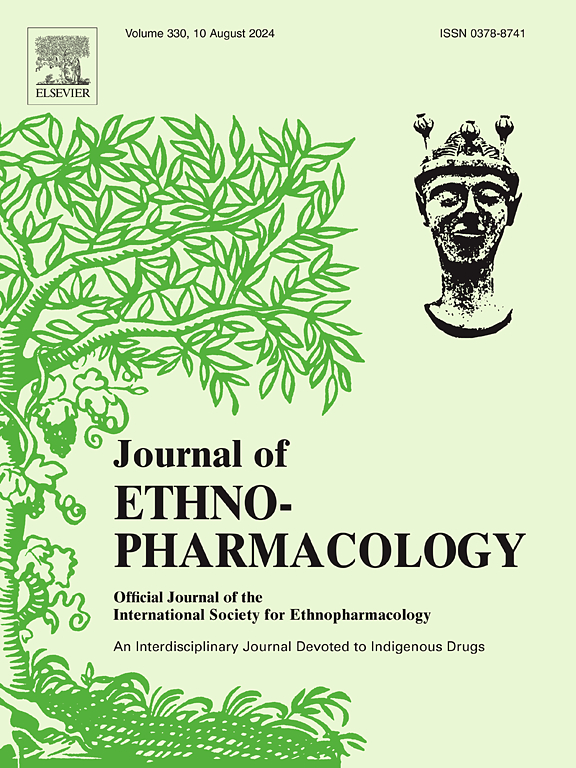清热消正益气方通过AMPK通路减轻糖尿病肾病肾足细胞铁下垂
IF 5.4
2区 医学
Q1 CHEMISTRY, MEDICINAL
引用次数: 0
摘要
糖尿病肾病(DKD)是一种常见的糖尿病微血管并发症,是终末期肾病(ESRD)的主要原因。新出现的证据暗示铁下垂与DKD发病机制有关。清热消正益气方(QRXZYQF)是一种具有30年临床应用历史的中药,具有多方面的药理作用。但它在DKD中的潜在作用尚未得到充分调查。本研究探讨QRXZYQF是否通过amp活化蛋白激酶(AMPK)通路激活,调节铁下垂,从而减轻足细胞损伤和减缓DKD进展。材料与方法雄性SD大鼠行左侧单侧肾切除术后腹腔注射链脲佐菌素(STZ, 50 mg/kg)诱导DKD。大鼠给药16周,分别给药12/24 g/kg、二甲双胍(100 mg/kg)、缬沙坦(8 mg/kg)。评估肾功能、血糖、血脂、24小时尿蛋白(24 h-UTP)、氧化应激标志物谷胱甘肽(GSH)和丙二醛(MDA)以及组织病理学。在体外,对高糖培养的条件永生化小鼠足细胞(MPC-5)细胞进行细胞活力测定、铁下垂标志物、线粒体完整性和AMPK信号传导分析。此外,我们利用短发夹RNA (short hairpin RNA, shRNA)抑制AMPK的表达,以证实QRXZYQF是否通过AMPK介导的铁下垂信号对DKD发挥保护作用。结果qrxzyqf改善DKD大鼠的体重、糖脂代谢和肾功能,减轻肾脏组织病理、肾纤维化和线粒体损伤。此外,QRXZYQF上调铁中毒相关蛋白谷胱甘肽过氧化物酶4 (GPX4)和溶质载体家族7成员11 (SLC7A11)的表达,下调酰基辅酶a合成酶长链家族成员4 (ACSL4)的表达,并减轻氧化应激。此外,AMPK沉默部分逆转了QRXZYQF的保护作用,证实了AMPK依赖性铁下垂抑制。结论sqrxzyqf通过激活AMPK信号通路,减缓DKD进展,从而抑制足细胞铁下垂。这些发现强调了其作为DKD治疗剂的潜力。本文章由计算机程序翻译,如有差异,请以英文原文为准。

Qing-Re-Xiao-Zheng-(Yi-Qi) formula attenuates the renal podocyte ferroptosis in diabetic kidney disease through AMPK pathway
Ethnopharmacological relevance
Diabetic kidney disease (DKD), a prevalent microvascular complication of diabetes, is a leading cause of end-stage renal disease (ESRD). Emerging evidence implicates ferroptosis in DKD pathogenesis. Qing-Re-Xiao-Zheng-(Yi-Qi) Formula (QRXZYQF), a traditional Chinese medicine with a 30-year clinical application history, exhibits multifaceted pharmacological benefits. But its potential role in DKD has yet to be fully investigated.
Aim of the study
This study investigates whether QRXZYQF alleviates podocyte injury and mitigates DKD progression by modulating ferroptosis through AMP-activated protein kinase (AMPK) pathway activation.
Materials and methods
We induced DKD in male sprague dawley (SD) rats by performing left unilateral nephrectomy followed by a single intraperitoneal injection of streptozotocin (STZ, 50 mg/kg). Rats received QRXZYQF (12/24 g/kg), metformin (100 mg/kg), and valsartan (8 mg/kg) for 16 weeks. Renal function, blood glucose, lipid profiles, 24-h urinary protein (24 h-UTP), oxidative stress markers glutathione (GSH) and malondialdehyde (MDA), and histopathology were assessed. In vitro, high-glucose-cultured conditionally immortalized mouse podocytes (MPC-5) cells were analyzed for cell viability assays, ferroptosis markers, mitochondrial integrity, and AMPK signaling. Additionally, we used short hairpin RNA (shRNA) to suppress AMPK expression to confirm whether QRXZYQF exerts protective effects on DKD via AMPK-mediated ferroptosis signaling.
Results
QRXZYQF improved body weight, glucose-lipid metabolism, and renal function in DKD rats, and alleviated kidney tissue pathology, renal fibrosis and mitochondrial damage. Furthermore, QRXZYQF upregulated the expression of ferroptosis-related proteins glutathione peroxidase 4 (GPX4) and solute carrier family 7 member 11 (SLC7A11) while downregulating acyl CoA synthase long-chain family member 4 (ACSL4) expression, and attenuated oxidative stress. Moreover, AMPK silencing partially reversed QRXZYQF's protective effects, confirming AMPK-dependent ferroptosis inhibition.
Conclusions
QRXZYQF attenuates DKD progression by activating AMPK signaling, thereby suppressing podocyte ferroptosis. These findings underscore its potential as a therapeutic agent for DKD.
求助全文
通过发布文献求助,成功后即可免费获取论文全文。
去求助
来源期刊

Journal of ethnopharmacology
医学-全科医学与补充医学
CiteScore
10.30
自引率
5.60%
发文量
967
审稿时长
77 days
期刊介绍:
The Journal of Ethnopharmacology is dedicated to the exchange of information and understandings about people''s use of plants, fungi, animals, microorganisms and minerals and their biological and pharmacological effects based on the principles established through international conventions. Early people confronted with illness and disease, discovered a wealth of useful therapeutic agents in the plant and animal kingdoms. The empirical knowledge of these medicinal substances and their toxic potential was passed on by oral tradition and sometimes recorded in herbals and other texts on materia medica. Many valuable drugs of today (e.g., atropine, ephedrine, tubocurarine, digoxin, reserpine) came into use through the study of indigenous remedies. Chemists continue to use plant-derived drugs (e.g., morphine, taxol, physostigmine, quinidine, emetine) as prototypes in their attempts to develop more effective and less toxic medicinals.
 求助内容:
求助内容: 应助结果提醒方式:
应助结果提醒方式:


